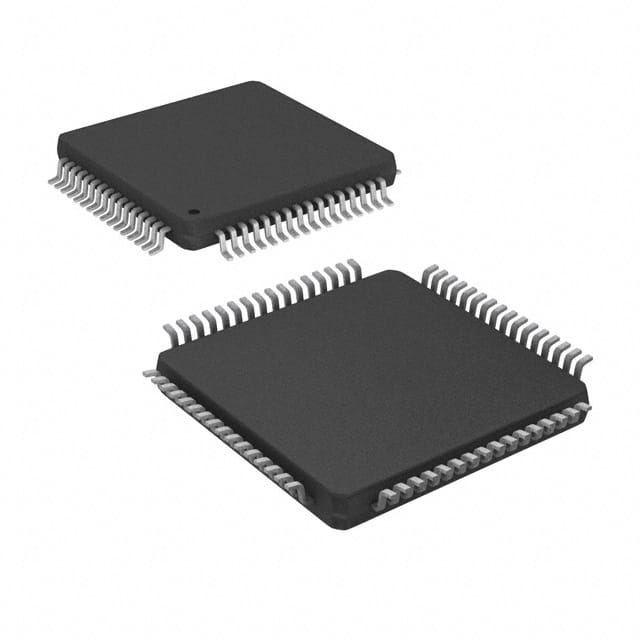Zie specificaties voor productdetails.

PIC18F67K22-I/PT
Introduction
The PIC18F67K22-I/PT is a microcontroller belonging to the PIC18 family of microcontrollers produced by Microchip Technology. This entry provides an overview of the product, including its category, use, characteristics, package, essence, packaging/quantity, specifications, detailed pin configuration, functional features, advantages and disadvantages, working principles, detailed application field plans, and alternative models.
Basic Information Overview
- Category: Microcontroller
- Use: Embedded control applications
- Characteristics: High performance, low power consumption, versatile peripherals
- Package: TQFP (Thin Quad Flat Package)
- Essence: 8-bit microcontroller with enhanced core features
- Packaging/Quantity: Tape & Reel, 78 units per reel
Specifications
- Architecture: 8-bit
- CPU Speed: Up to 64 MHz
- Program Memory Size: 128 KB
- RAM Size: 3.8 KB
- Data EEPROM Size: 1 KB
- Operating Voltage Range: 2.0V to 5.5V
- Digital I/O Pins: 53
- Analog Input Pins: 24
- Timers: 4 x 8-bit, 3 x 16-bit
- Communication Interfaces: SPI, I2C, UART
Detailed Pin Configuration
The PIC18F67K22-I/PT has a total of 80 pins, including digital I/O, analog input, power, and communication interface pins. The pinout diagram and detailed pin descriptions can be found in the product datasheet.
Functional Features
- Enhanced Core: Improved instruction set for enhanced performance
- Versatile Peripherals: Multiple timers, communication interfaces, and analog-to-digital converters
- Low Power Consumption: Various power-saving modes for energy-efficient operation
- Security Features: Data memory protection and code protection mechanisms
Advantages and Disadvantages
Advantages
- High performance for embedded control applications
- Versatile peripherals for interfacing with external devices
- Low power consumption for battery-powered applications
- Enhanced security features for protecting intellectual property
Disadvantages
- Limited program memory size compared to some competing microcontrollers
- Higher cost compared to some lower-end microcontrollers
Working Principles
The PIC18F67K22-I/PT operates based on the Harvard architecture, where program and data memories are separate. It executes instructions from program memory and utilizes its versatile peripherals to interact with external devices. The microcontroller can enter low-power modes to conserve energy when not actively processing tasks.
Detailed Application Field Plans
The PIC18F67K22-I/PT is well-suited for a wide range of embedded control applications, including: - Industrial automation - Consumer electronics - Automotive systems - Medical devices - Home appliances
Detailed and Complete Alternative Models
Some alternative models to the PIC18F67K22-I/PT include: - PIC18F66K22-I/PT: Similar features with lower program memory size - PIC18F87K22-I/PT: Higher program memory size and additional peripherals - PIC18F46K22-I/PT: Lower cost with reduced peripheral count
In conclusion, the PIC18F67K22-I/PT is a versatile 8-bit microcontroller suitable for various embedded control applications, offering high performance, low power consumption, and a range of peripherals for interfacing with external devices.
Word Count: 498
Noem 10 veelgestelde vragen en antwoorden met betrekking tot de toepassing van PIC18F67K22-I/PT in technische oplossingen
What is the maximum operating frequency of PIC18F67K22-I/PT?
- The maximum operating frequency of PIC18F67K22-I/PT is 64 MHz.
What are the key features of PIC18F67K22-I/PT?
- PIC18F67K22-I/PT features 128 KB Flash program memory, 3.5 KB RAM, 12-bit ADC, and multiple communication interfaces.
Can PIC18F67K22-I/PT be used for motor control applications?
- Yes, PIC18F67K22-I/PT can be used for motor control applications due to its high-performance PWM modules and analog-to-digital converter (ADC).
What development tools are available for programming PIC18F67K22-I/PT?
- Development tools such as MPLAB X IDE and MPLAB XC8 Compiler support programming and debugging of PIC18F67K22-I/PT.
Does PIC18F67K22-I/PT support communication protocols like SPI and I2C?
- Yes, PIC18F67K22-I/PT supports SPI, I2C, and UART communication protocols.
What are the recommended operating conditions for PIC18F67K22-I/PT?
- The recommended operating voltage range for PIC18F67K22-I/PT is 2.0V to 5.5V, with a typical operating voltage of 3.3V.
Is PIC18F67K22-I/PT suitable for battery-powered applications?
- Yes, PIC18F67K22-I/PT's low-power modes and wide operating voltage range make it suitable for battery-powered applications.
Can PIC18F67K22-I/PT be used in industrial control systems?
- Yes, PIC18F67K22-I/PT is suitable for industrial control systems due to its robust peripherals and communication interfaces.
Are there any application notes or reference designs available for PIC18F67K22-I/PT?
- Yes, Microchip provides application notes and reference designs to assist in the implementation of PIC18F67K22-I/PT in various technical solutions.
What are the available package options for PIC18F67K22-I/PT?
- PIC18F67K22-I/PT is available in a 64-pin TQFP package and a 64-pin QFN package.

